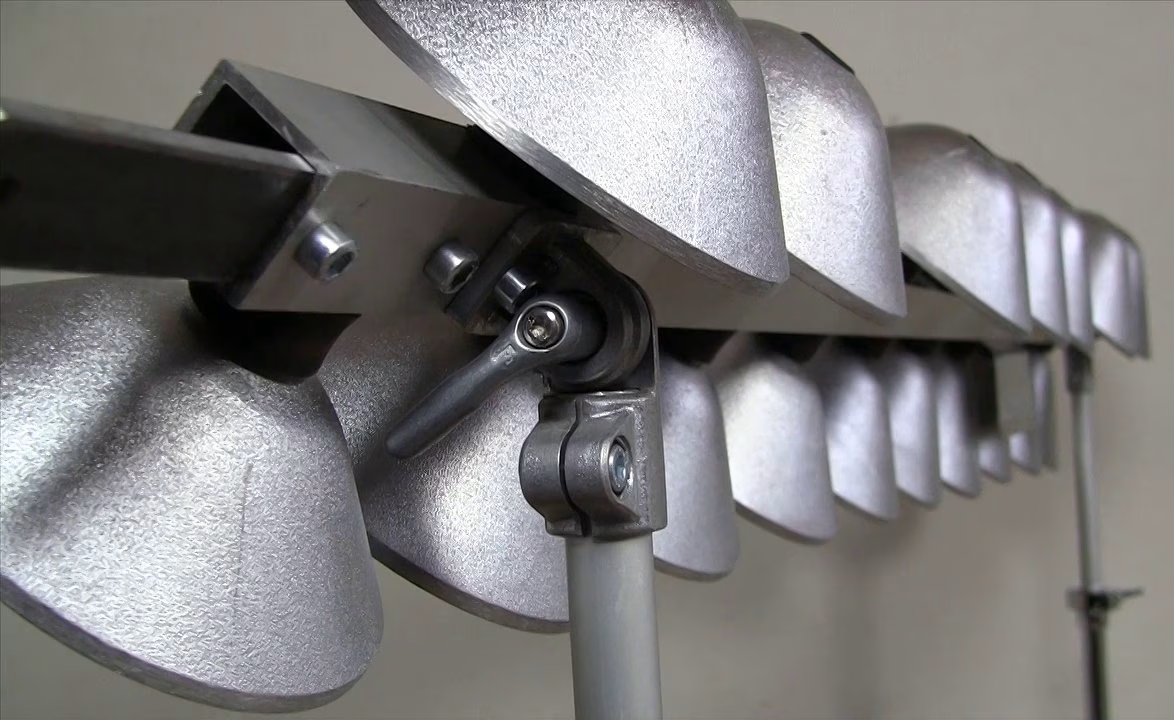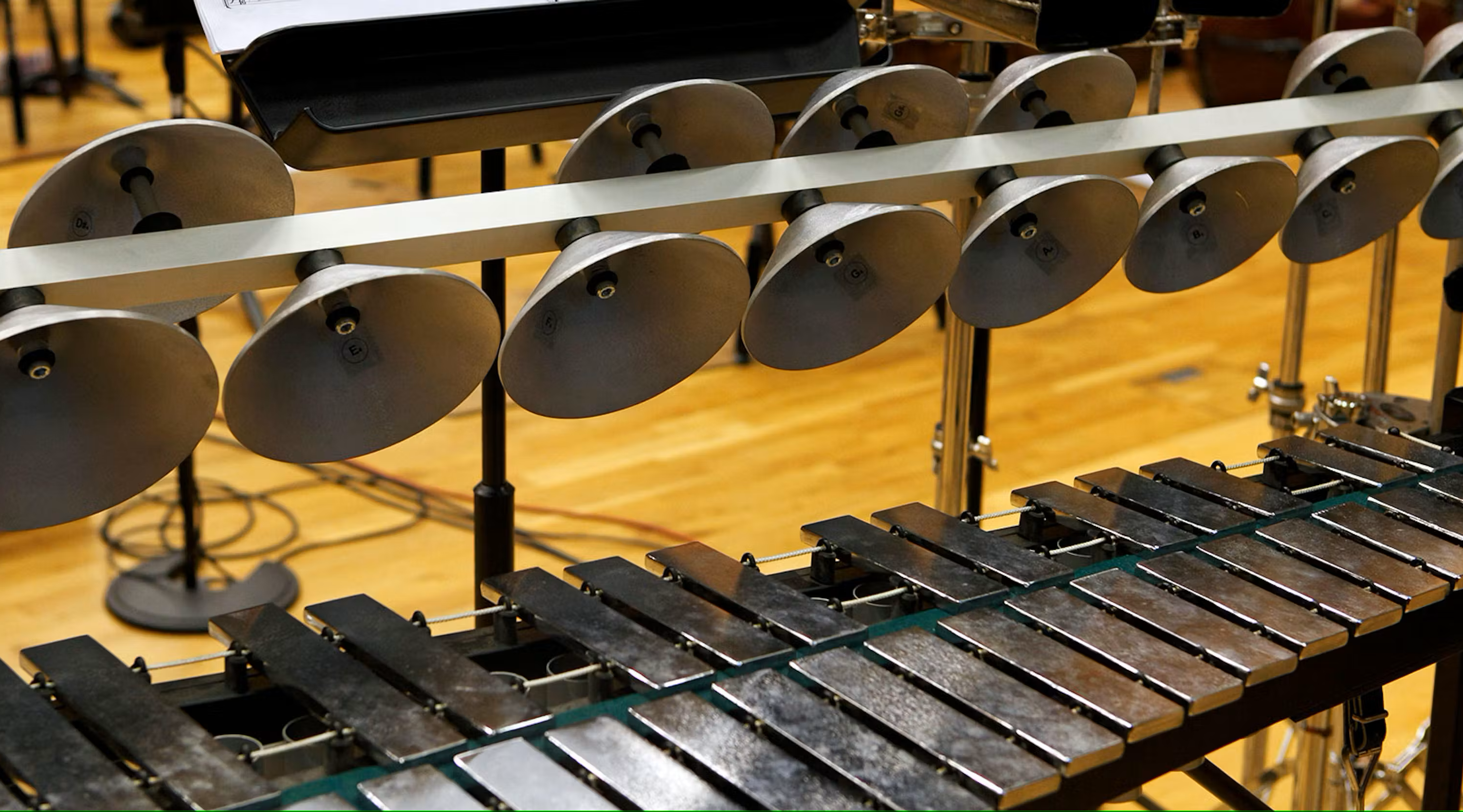Aluphone
Melodic Percussions
Europe
Between 1901 and present
Video
The Aluphone is a relatively modern percussion instrument that has gained recognition for its unique tonal qualities and versatility. It consists of aluminum bells arranged in a manner similar to a vibraphone or a glockenspiel. These bells vary in size and are carefully tuned to produce a resonant and ethereal sound when struck with mallets. The instrument’s shimmering, metallic tone makes it suitable for various musical genres, including orchestral compositions, film scores, and contemporary percussion ensembles.
The Aluphone is classified as an idiophone, a category of musical instruments in which the sound is produced primarily by the vibration of the instrument itself, without the need for strings, membranes, or external resonators. The aluminum bells are mounted on a frame, and their free vibration ensures that they produce a pure and sustained tone. Because of its construction, the Aluphone has a distinct sound that blends the brightness of a glockenspiel with the warm resonance of a vibraphone.
Types and Features
The Aluphone comes in different configurations to suit various musical applications. The most common types include:
Concert Aluphone – This version is designed for orchestral and ensemble use, featuring a well-structured arrangement of bells that allow for both melodic and harmonic play. It is often used in contemporary classical compositions.
Solo Aluphone – This type is customized for solo performances and offers an extended range of bells, giving the performer greater melodic and harmonic flexibility.
Compact Aluphone – A smaller and more portable version, this is ideal for musicians who require mobility without compromising sound quality. It is commonly used in experimental and fusion music.
Mounted Aluphone – Some models are designed to be mounted onto drum sets or percussion rigs, allowing for integration with other percussion instruments in various musical settings.
The features of the Aluphone make it a highly expressive instrument. It can be played using mallets of different hardness levels, which significantly affect the tone and dynamics. Soft mallets produce a warm, mellow sound, while hard mallets create a bright and penetrating tone. Some musicians also experiment with bowing techniques, rubbing the aluminum bells with a violin or cello bow to create eerie, sustained sounds.
History and Origin
The Aluphone is a relatively recent addition to the family of percussion instruments. Unlike traditional instruments with centuries of history, the Aluphone was developed in the early 21st century by Danish percussionists and instrument makers. Its invention was driven by the desire to create a unique percussion instrument that could offer both melodic and harmonic capabilities while producing an innovative sound.
Continent and Century
The Aluphone was developed in Europe, specifically in Denmark, in the early 2000s. It was designed through extensive research into the acoustic properties of aluminum and its ability to produce sustained and resonant tones. The instrument’s development was influenced by existing metallophones, such as the vibraphone and glockenspiel, but it introduced a distinct sound due to the material and design of its bells.
The instrument gained popularity after being featured in high-profile performances, including the London 2012 Olympic Games, where it was used in the opening ceremony. Since then, it has been incorporated into symphony orchestras, percussion ensembles, and experimental music compositions worldwide.
Work Mechanics
The Aluphone operates on the principle of struck idiophones. The bells, made from specially crafted aluminum, vibrate when struck with mallets, producing a resonant and harmonically rich tone. The mechanics of sound production in the Aluphone are influenced by the size, shape, and placement of the bells.
Each bell is individually tuned to a specific pitch, and the spacing between them allows for clear note articulation. The instrument does not require additional amplification, as the aluminum material naturally enhances the sustain and projection of the sound. However, in larger performance settings, microphones can be used to capture and amplify its delicate overtones. Performers can control dynamics and articulation through different playing techniques. Striking the bells with varying degrees of force alters the volume and intensity of the sound. Additionally, using mallets with different materials (e.g., rubber, yarn-wrapped, or wooden) influences the timbre, allowing for a broad spectrum of tonal colors.
Some advanced players use alternative techniques such as bowing or electronic processing to create extended soundscapes. The Aluphone’s ability to produce ethereal and bell-like tones makes it an appealing instrument for composers seeking unique sonic textures.
Role in Music
The Aluphone serves a versatile role in music, bridging the gap between traditional percussion and melodic instruments. Its ability to produce sustained and resonant tones makes it suitable for a wide range of musical genres and compositions.
In orchestral settings, the Aluphone is often used as a melodic and harmonic instrument, adding a distinct shimmering quality to the ensemble. Composers incorporate it into their works to create atmospheric effects, especially in film scores and contemporary classical music. The instrument’s bell-like timbre blends well with strings, woodwinds, and electronic elements, making it an excellent choice for modern compositions. In percussion ensembles, the Aluphone adds a rich harmonic layer, complementing instruments such as marimbas, vibraphones, and gongs. Its sound can be both percussive and melodic, allowing for intricate interplay with other instruments in an ensemble setting.
Furthermore, the Aluphone has found its place in experimental and electronic music. Artists exploring new soundscapes use the instrument’s unique overtones to create ambient textures and unconventional harmonies. With the aid of electronic effects and processing, the Aluphone’s sound can be manipulated to fit avant-garde and contemporary music styles.
Significance of the Aluphone
The Aluphone holds significant value in the world of modern percussion. Its invention has expanded the range of available idiophones, offering composers and performers new sonic possibilities. The instrument’s distinct timbre, combined with its melodic capabilities, makes it a valuable addition to various musical settings.
One of the key aspects of its significance is its ability to produce sustained, resonant tones that blend well with other instruments. This characteristic has made it a favorite in film scoring and contemporary classical compositions. The instrument’s shimmering and celestial sound can evoke emotions and create atmospheric depth in musical pieces. Additionally, the Aluphone’s adaptability in different musical contexts highlights its importance. Whether used in orchestral performances, solo recitals, or electronic music experiments, it continues to push the boundaries of percussion music. Its presence in the 2012 London Olympic Games solidified its reputation as an instrument of global recognition, sparking interest among musicians and composers worldwide.
The Aluphone is also significant in music education and percussion studies. As a new and innovative instrument, it encourages percussionists to explore different tonal possibilities and expand their expressive range. Universities and conservatories have begun incorporating it into their percussion programs, further cementing its role in the evolution of contemporary percussion.
FAQ
What are the unique characteristics of the Aluphone?
The Aluphone is known for its unique blend of sounds reminiscent of the vibraphone, gamelan, and Tibetan singing bowl. It is made from durable aluminum bells that can be played with various mallets to achieve different tones. The instrument's sound remains consistent across different environmental conditions, making it suitable for outdoor performances.
Where did the Aluphone originate?
The Aluphone originated in Europe, specifically through the collaboration between Michael Hansen and Kai Stensgaard. It was first presented at the Percussive Arts Society International Convention (PASIC) in 2011.
How is the Aluphone used in music?
The Aluphone is used in a variety of musical genres, including classical, pop, and contemporary music. It has been featured in orchestral compositions and is popular among percussionists for its unique sound. The instrument is often played alongside other percussion instruments like the marimba.
 Links
Links
References
Other Instrument
Categories



















